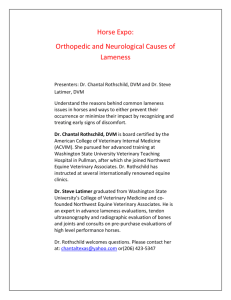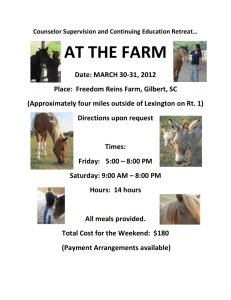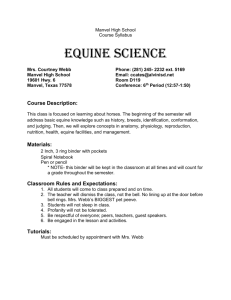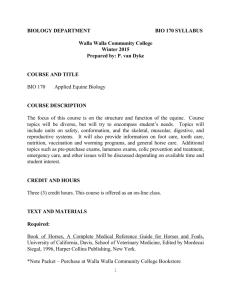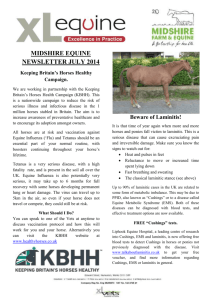7:00 - 8:00 AM Registration and Continental Breakfast (sponsored
advertisement
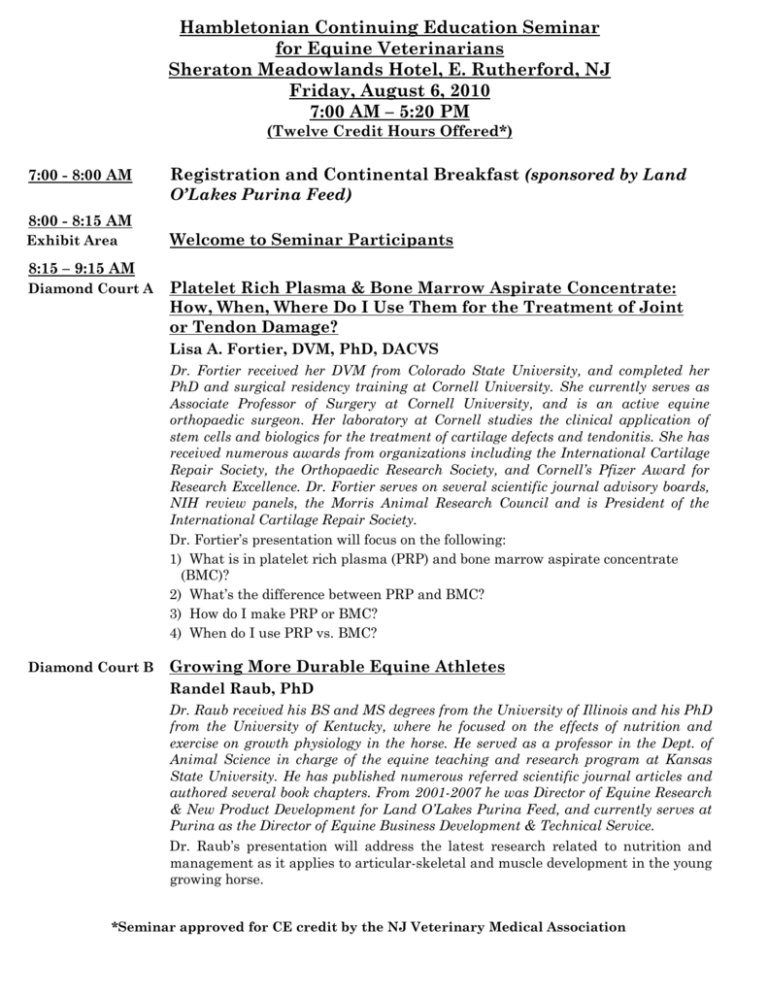
Hambletonian Continuing Education Seminar for Equine Veterinarians Sheraton Meadowlands Hotel, E. Rutherford, NJ Friday, August 6, 2010 7:00 AM – 5:20 PM (Twelve Credit Hours Offered*) 7:00 - 8:00 AM Registration and Continental Breakfast (sponsored by Land O’Lakes Purina Feed) 8:00 - 8:15 AM Exhibit Area Welcome to Seminar Participants 8:15 – 9:15 AM Diamond Court A Platelet Rich Plasma & Bone Marrow Aspirate Concentrate: How, When, Where Do I Use Them for the Treatment of Joint or Tendon Damage? Lisa A. Fortier, DVM, PhD, DACVS Dr. Fortier received her DVM from Colorado State University, and completed her PhD and surgical residency training at Cornell University. She currently serves as Associate Professor of Surgery at Cornell University, and is an active equine orthopaedic surgeon. Her laboratory at Cornell studies the clinical application of stem cells and biologics for the treatment of cartilage defects and tendonitis. She has received numerous awards from organizations including the International Cartilage Repair Society, the Orthopaedic Research Society, and Cornell’s Pfizer Award for Research Excellence. Dr. Fortier serves on several scientific journal advisory boards, NIH review panels, the Morris Animal Research Council and is President of the International Cartilage Repair Society. Dr. Fortier’s presentation will focus on the following: 1) What is in platelet rich plasma (PRP) and bone marrow aspirate concentrate (BMC)? 2) What’s the difference between PRP and BMC? 3) How do I make PRP or BMC? 4) When do I use PRP vs. BMC? Diamond Court B Growing More Durable Equine Athletes Randel Raub, PhD Dr. Raub received his BS and MS degrees from the University of Illinois and his PhD from the University of Kentucky, where he focused on the effects of nutrition and exercise on growth physiology in the horse. He served as a professor in the Dept. of Animal Science in charge of the equine teaching and research program at Kansas State University. He has published numerous referred scientific journal articles and authored several book chapters. From 2001-2007 he was Director of Equine Research & New Product Development for Land O’Lakes Purina Feed, and currently serves at Purina as the Director of Equine Business Development & Technical Service. Dr. Raub’s presentation will address the latest research related to nutrition and management as it applies to articular-skeletal and muscle development in the young growing horse. *Seminar approved for CE credit by the NJ Veterinary Medical Association 9:20 – 10:20 AM Diamond Court A Non-Standard Radiographic Projections for Equine Musculoskeletal Imaging Alex Valdés-Martínez, DVM, DACVR Dr. Alex Valdés-Martínez received his veterinary degree from the Universidad Autónoma de Nuevo León, Mexico. Several years of equine medicine and surgery practice, both in private referral hospitals (México and Southern California) and academia (Louisiana State University) preceded 3 years of specialty training in veterinary radiology at the University of Pennsylvania. He currently serves as an Assistant Professor in Diagnostic Imaging at Colorado State University. Dr. ValdésMartínez’ special clinical interests are orthopedic and cancer-related musculoskeletal diseases in all species. Dr. Valdés-Martínez’ presentation will examine the advantages of additional projections to complement a standard radiographic exam. Diamond Court B Care of the Geriatric Horse David G. Pugh, DVM, MS, DACT, DACVN Dr. Pugh received his MS and DVM degrees from the University of Georgia. He trained in equine nutrition at Virginia Tech and theriogenology at Texas A&M. He has owned a large animal practice, and spent 14 years at Auburn University as a large animal professor specializing in nutrition and reproductive medicine, and is a Diplomate of both the American College of Theriogenologists and the American College of Veterinary Nutrition. Dr. Pugh recently served as a Consulting Veterinarian for Fort Dodge Animal Health and Pfizer Animal Health. He is presently a Clinical Research Fellow at Auburn University and Project Veterinarian for the North Auburn Equine Unit. This presentation will cover the nutritional and medical care of the aged horse. Topics discussed will be diet modification, specific medical conditions, parasite control, and treatment modalities the veterinarian can use to enhance the health of the geriatric horse. The discussion will cover practical information that is directly applicable to field conditions. 10:20 – 10:50 AM Exhibit Area Morning Break/Refreshments (sponsored by Merial & Milburn Equine) 10:50 – 11:50 PM Diamond Court A Equine Protozoal Myeloencephalitis: Diagnosis, Treatment & Prognosis Thomas J. Divers, DVM, DACVIM, DACVECC Dr. Divers is a graduate of the University of Georgia, completed an internship at the University of California at Davis, and a residency at the University of Georgia in both internal medicine and ambulatory practice. He was a faculty member at the University of Georgia in both ambulatory and internal medicine for 2 years. He then moved to New Bolton Center, University of Pennsylvania, for the next 10 years where he served as a professor of medicine and Chief of the section of medicine. Dr. Divers is currently Professor and Chief of Large Animal Medicine at Cornell University College of Veterinary Medicine. Dr. Divers will discuss epidemiology and history, clinical signs, differential diagnoses, laboratory testing and clinical responses that are important in making the diagnosis of EPM. Treatment options, predicting prognosis and prevention will be reviewed in detail. The information provided in this presentation will mostly be based upon clinical-based evidence, with some personal beliefs obtained from 35 years of clinical and research experiences. Diamond Court B Nonsteroidal Anti-inflammatory Drug Use for Management of Joint Disease Christopher E. Kawcak, DVM, PhD, DACVS Dr. Kawcak earned his DVM from Colorado State University and then interned at Rood & Riddle Equine Hospital. He returned to Colorado State University for his residency and PhD, and joined the faculty in 1998. Dr. Kawcak currently serves as an Associate Professor in the Equine Orthopaedic Research Center at Colorado State. His clinical interests include lameness diagnosis and orthopaedic surgery. He devotes most of his time to research in the areas of the diagnosis and treatment of musculoskeletal disease and the development of biomechanical models of joint injury. NSAIDs have long been instrumental for the management of joint pain, and the development of more selective medications have made decision making more difficult. This talk will review NSAID use in horses for management of joint pain. 11:50 – 1:45 PM Exhibit Area Exhibitor Displays and Buffet Lunch (sponsored by Boehringer Ingelheim & Intervet/Schering-Plough) 1:45 – 2:45 PM Diamond Court A Equine Cushing's Disease: From Hirsutism to Optimism Marian Little, DVM Dr. Little earned her DVM from the University of Tennessee. She completed her internship in equine medicine and surgery at Mississippi State University. Following internship, Dr. Little practiced in both Tennessee and Virginia, focusing on western, gaited, and sport horses. She joined Boehringer Ingelheim in 2007 as an Equine Professional Services Veterinarian. Her interests include internal medicine, equine endocrinology, laminitis, and vaccinology. Dr. Little currently serves as primary field technical support for Boehringer Equine Division, and is actively involved in many areas, including field studies, pipeline projects, and conducting educational meetings for both veterinarians and distributor partners. Equine Cushing’s disease (ECD), or Pituitary pars intermedia dysfunction (PPID), is a debilitating disease that affects an estimated 15% of horses and ponies over 15 years of age. As ECD progresses, laminitis and other conditions occur which make daily management of affected horses challenging and frustrating for both veterinarians and horse owners. This presentation will discuss the pathophysiology of the disease, practical field diagnostics, and current treatment options for the ECD horse. Successful management of ECD horses requires a “whole-horse” approach. After the presentation, the speaker encourages attendees to openly share their successes and challenges in treating this disease. Diamond Court B Equine Ocular Emergencies John S. Sapienza, DVM, DACVO Dr. Sapienza received his BS and DVM from Cornell Univ. He completed his internship in small animal medicine and surgery at the Animal Medical Center, NYC, and his residency in comparative ophthalmology at the Univ. of Florida CVM. Dr. Sapienza is the consultant veterinary ophthalmologist at the Bronx Zoo and the NY Aquarium. He has special interests in cataract surgery with phacofragmentation, intraocular lens implantation, laser glaucoma therapy, glaucoma implants and reconstructive eyelid procedures and is the author of numerous articles on these subjects. Dr. Sapienza has a small animal and equine ophthalmology referral practice at Long Island Veterinary Specialists. He lectures extensively across the US and abroad. Emergency ocular diseases in horses can be devastating. Prompt attention to extraocular and intraocular damage, as well as a close working relationship with your referral ophthalmologist, is paramount to maximizing a successful outcome. Proper examination techniques in addition to case presentation will be emphasized. 2:50 – 3:50 PM Diamond Court A New Studies Using Intra-Articular Polyglycan for Osteoarthritis in Horses Christopher E. Kawcak, DVM, PhD, DACVS (bio above) Polyglycan is a combination intra-articular medication composed of glucosamine, chondroiton and hyaluronic acid. It has shown beneficial effects in an osteochondral fragment model of osteoarthritis in horses. The effects have been both disease and symptom modifying. Diamond Court B How to Locate that Spinal Cord Lesion - Some Illustrative Equine Neurologic Cases Robert MacKay, BVSc, PhD, DACVIM Dr. MacKay received his BVSc from Massey University, New Zealand. After several years in dairy cattle practice, he moved to the US and completed his internship at the University of California at Davis. Dr. MacKay was a highly-honored resident at the University of Florida, where he also earned his PhD. He has been on the faculty at the University of Florida since 1987, where he currently serves as a professor of large animal medicine. His expertise includes general internal medicine with a special interest in clinical neurology of large animals. His research interests are also in the area of inflammation/endotoxemia and in the diagnosis and biology of EPM. Neurologic cases are rare and often confusing. The first step in diagnosis is lesion localization. Dr. MacKay’s presentation will explore the art and science of neurologic examination. The topic will be illustrated with video case material. 3:50 – 4:20 PM Exhibit Area 4:20 – 5:20 PM Diamond Court A Afternoon Break/Refreshments (sponsored by Arthrodynamic Technologies and PulseVet/VersaTron) Use of MRI to Provide Answers in Undiagnosed Lameness Brendan W. Furlong, MVB, MRCVS Dr. Furlong graduated from the Veterinary College of Ireland, and came to the US in 1977 to complete his internship. He started his own equine veterinary practice in 1980. Dr. Furlong has been involved exclusively with performance horses and his practice has evolved into one of the premier equine sport horse practices on the east coast. His area of special interest is in Sport Horse performance, especially lameness and loss of performance. Pre-purchase exams are also a specialty of Dr. Furlong’s and his expertise and reputation in that area have taken him all over the world. In the late ‘80’s he worked extensively with standardbreds, and was a consultant to the largest standardbred training and breeding facilities in NJ. He has served the US Equestrian Team in numerous capacities over the last 15 years. Acute onset lameness that is easily localized but eludes diagnosis by traditional methods (e.g. radiography, ultrasound) is one of the most frustrating issues faced by equine practitioners. MRI has offered new insight in our understanding of lameness; identifying the specific cause of lameness in many of these cases. And with specific early diagnosis, appropriate treatment can be implemented to aid clients in achieving the best possible outcomes for their horses. Diamond Court B How Gut-derived Bacteria Influence the Incidence of Laminitis Janet Onishi, PhD Dr. Onishi earned her PhD from Rutgers University. As a former pharmaceutical research scientist at Merck and Company, Inc, Dr. Onishi has a proven track record in the discovery and development of novel natural products including CANCIDAS, an antifungal used to treat life-threatening fungal infections. Her area of expertise is the design of and validation of biochemical and whole cell in vitro and in vivo assays used to discover and develop small molecules and vaccines. She is currently a Visiting Scientist at Rutgers pursuing an independent research project that seeks to improve the life of horses affected with laminitis. The presence of potentially pathogenic bacteria in laminae tissue could represent a subclinical infection and account for the persistence of laminitis in the chronically laminitic horse. Further research is needed to investigate the involvement of bacteria in the development of acute and chronic phase of this laminar disease.


